Page 494 of 526

A
AP
PP
PE
EA
A R
RA
A N
N C
CE
E
C
C A
A R
RE
E
7-76
Maintenance
Exterior Care
Exterior general caution
It is very important to follow the label
directions when using any chemical
cleaner or polish. Read all warning and
caution statements that appear on the
label.
High-pressure washing
When using high-pressure washers,
make sure to maintain sufficient dis-
tance from the vehicle. Insufficient
clearance or excessive pressure can
lead to component damage or water
penetration.
Do not spray the camera, sensors or its surrounding area directly with a high
pressure washer. Shock applied from
high pressure water may cause the
device to not operate normally.
Do not bring the nozzle tip close to boots (rubber or plastic covers)or con-
nectors as they may be damaged if
they come into contact with high pres-
sure water.
Do not use any high-pressure nozzles, which induce either one-direct water
stream or water swirling.
Protecting your vehicle’s finish
Washing
To help protect your vehicle’s finish from
rust and deterioration, wash it thoroughly
and frequently at least once a month with
lukewarm or cold water.
If you use your vehicle for off-road driv-
ing, you should wash it after each off-
road trip. Pay special attention to the
removal of any accumulation of salt, dirt,
mud, and other foreign materials. Make
sure the drain holes in the lower edges of
the doors and rocker panels are kept
clear and clean.
Insects, tar, tree sap, bird droppings,
industrial pollution and similar deposits
can damage your vehicle’s finish if not
removed immediately.
Even prompt washing with plain water
may not completely remove all these
deposits. A mild soap, safe for use on
painted surfaces, should be used.
After washing, rinse the vehicle thor-
oughly with lukewarm or cold water. Do
not allow soap to dry on the finish. Do not use strong soap, chemical
detergents or hot water, and do not
wash the vehicle in direct sunlight
or when the body of the vehicle is
warm.
Be careful when washing the side windows of your vehicle.
Especially, with high-pressure
water, water may leak through the
windows and wet the interior.
To prevent damage to the plastic parts, do not clean with chemical
solvents or strong detergents.
NOTICE
After washing the vehicle, test the
brakes while driving slowly to see if
they have been affected by water
before getting on the road. If brak-
ing performance is impaired, dry
the brakes by applying them lightly
while maintaining a slow forward
speed.
WARNING
Page 496 of 526

7-78
Maintenance
Bright-metal maintenance
To remove road tar and insects, use atar remover, not a scraper or other
sharp object.
To protect the surfaces of bright-metal parts from corrosion, apply a coating of
wax or chrome preservative and rub to
a high luster.
During winter weather or in coastal areas, cover the bright metal parts with
a heavier coating of wax or preserva-
tive. If necessary, coat the parts with
non-corrosive petroleum jelly or other
protective compound.
Underbody maintenance
Corrosive materials used for ice and
snow removal and dust control may col-
lect on the underbody. If these materials
are not removed, accelerated rusting can
occur on underbody parts such as the
fuel lines, frame, floor pan and exhaust
system, even though they have been
treated with rust protection. Thoroughly flush the vehicle underbody
and wheel openings with lukewarm or
cold water once a month, after off-road
driving and at the end of each winter. Pay
special attention to these areas because
it is difficult to see all the mud and dirt. It
will do more harm than good to wet down
the road grime without removing it. The
lower edges of doors, rocker panels, and
frame members have drain holes that
should not be allowed to clog with dirt;
trapped water in these areas can cause
rusting.
Aluminum wheel maintenance
The aluminum wheels are coated with a
clear protective finish.
Do not use abrasive cleaner, polish-
ing compound, solvent, or wire
brushes on aluminum wheels.
Clean the wheel when it has cooled.
Use only a mild soap or neutral detergent, and rinse thoroughly with
water. Also, clean the wheels after
driving on salted roads.
Do not wash the wheels with high- speed car wash brushes.
Do not use any cleaners containing acid or alkaline detergents.
NOTICE
After washing the vehicle, test the
brakes while driving slowly to see if
they have been affected by water. If
braking performance is impaired,
dry the brakes by applying them
lightly while maintaining a slow for-
ward speed.
WARNING
Page 524 of 526

I-7
Owner Maintenance ..........................................................7-4Owner Maintenance Schedule......................................7-5
Parking Brake .................................................................7-25 Checking the Parking Brake ......................................7-25
Recommended Lubricants and Capacities ........................8-7 Recommended SAE Viscosity Number .......................8-9
Refrigerant Label ............................................................8-11
Reporting Safety Defects ................................................8-13
Scheduled Maintenance Services .....................................7-6 Maintenance Under Severe Usage Conditions (Gamma 1.6 T-GDI) ................................................7-15
Maintenance Under Severe Usage Conditions (Nu 2.0 MPI) ...........................................................7-10
Normal Maintenance Schedule (Gamma 1.6 T-GDI) ................................................7-12
Normal Maintenance Schedule (Nu 2.0 MPI) .............7-7
Severe Driving Conditions .........................................7-11
Severe Driving Conditions .........................................7-16 Seat belts ........................................................................\
.2-18
Additional Seat Belt Safety Precautions ....................2-25
Care of Seat Belts .......................................................2-27
Seat Belt Restraint System .........................................2-20
Seat Belt Safety Precautions ......................................2-18
Seat Belt Warning Light .............................................2-19
Seats ........................................................................\
..........2-3 Front Seats ....................................................................2-5
Head Restraints ..........................................................2-12
Rear Seats ...................................................................2-10
Safety Precautions ........................................................2-4
Seat warmers ..............................................................2-16
Smart Cruise Control system ..........................................5-73 Limitations of the System ..........................................5-83
SCC Front Radar Sensor ............................................5-81
Smart Cruise Control Speed .......................................5-75
Smart Cruise Control Vehicle-to-Vehicle Distance ....5-79
To Adjust the Sensitivity of Smart Cruise Control ....5-74
To Convert to Cruise Control Mode ..........................5-75
Special Driving Conditions.............................................5-87 Driving at Night .........................................................5-88
Driving in Flooded Areas ...........................................5-89
Driving in the Rain .....................................................5-88
Hazardous Driving Conditions ...................................5-87
Highway Driving ........................................................5-89
Rocking the Vehicle ...................................................5-87
Smooth Cornering ......................................................5-88
I
Index
O
P
R
S